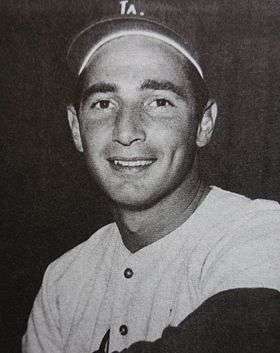Bonus Rule
The Bonus Rule was a rule instituted by Major League Baseball in 1947 that prevented teams from assigning certain players to farm clubs.[1] The rule stipulated that when a Major league team signed a player to a contract in excess of $4,000 ($42,500 today), the Major League team was required to keep that player on the 25-man roster for two full-seasons.[2] Any team that failed to comply with the rule lost the rights to that player's contract. The player was then exposed to the waiver wire.[1] If the player did remain with the team for a full two seasons, the team could then send that player down to the farm teams without repercussions. The rule went through several variations until it was finally abolished in 1965.
History of the rule
In the late 1930s and early 1940s, Major League franchises found themselves bidding against one another for the services of young players. These engagements subsided when World War II broke out. When the war ended, the bidding wars resumed.[1]
This competition for the best amateur athletes resulted in skyrocketing signing bonuses. In 1947, Major League baseball implemented the Bonus Rule. The rule prevented the wealthiest teams from signing all of the best players and from stashing those players in their farm systems. Additionally, the bonus market was weakened as a result of inhibited competition. In return, this limited labor costs.[1]
The legitimacy of the rule was challenged several times after it was initially implemented. In December 1950, the rule was rescinded.[1] In 1952, a committee chaired by Branch Rickey revived the rule. It was this iteration of the rule that stated a team had to place the players who met the Bonus Rule criteria on the Major League roster immediately. Furthermore, the player had to remain on the roster for two calendar years from the signing date.[1] Although the players were signed as a result of their potential, some players were not able to succeed. Pitcher Tom Qualters appeared in one game in the 1953 season. He did not appear in another game until 1957.
The New York Yankees worked out a deal with the Kansas City Athletics where the Athletics signed Clete Boyer to a contract.[1] The Athletics used Boyer sparingly for the two years they had him. Then, just days after the first date at which the Athletics could send Boyer down to the minor leagues, they traded him to the Yankees as the player to be named later from a trade the previous winter. This trade did not sit well with the owners of the other American League teams. They claimed that the Yankees had used the Athletics to hold Boyer. However, the deal was allowed by the league.[1]
Incidents like the Clete Boyer trade showed how the Bonus Rule could be circumvented. On top of that, rumor spread that teams were ignoring the rule and bribing players. In 1958, both leagues voted to rescind the rule. In addition, they rescinded it retroactively. This eliminated the major league roster requirement for the players signed in 1957.[1]
After the league added four new teams, the Bonus Rule was reintroduced in 1962. The difference between the new version of the rule and the previous one was that a player had to spend just one full season on the roster instead of two seasons.[1]
In June 1965, the Major League draft was introduced in baseball. Each drafted player was required to negotiate with the team that selected him. This brought an end to the Bonus Rule.
Bonus babies
Bonus babies were the group of amateur baseball players who went straight to the Major Leagues between the years 1947 and 1965 and received a signing bonus in excess of $4,000. The Bonus Rule prevented the player from spending time in the Minor League Baseball system that was, and is, the training ground for most professional baseball players in the United States of America, and this came under criticism because it often caused such a player to languish on a major league bench instead of getting experience in the minors.
Hall of Fame

Four of the 1947–1965 bonus babies actually produced Hall of Fame-worthy careers: Al Kaline, Harmon Killebrew, Sandy Koufax, and Catfish Hunter. Of the four, only Killebrew (a bonus baby for the Washington Senators) saw any minor league service time once his mandatory bonus baby period expired. Kaline, Koufax, and Hunter never played a single inning of Minor League Baseball.
See also
Notes
- 1 2 3 4 5 6 7 8 9 10 Treder, Steve. "Cash in the Cradle: The Bonus Babies". hardballtimes.com. Retrieved 2006-11-15.
- ↑ Kelley, Brent (1996), Baseball's Biggest Blunder, New York City: Scarecrow Press